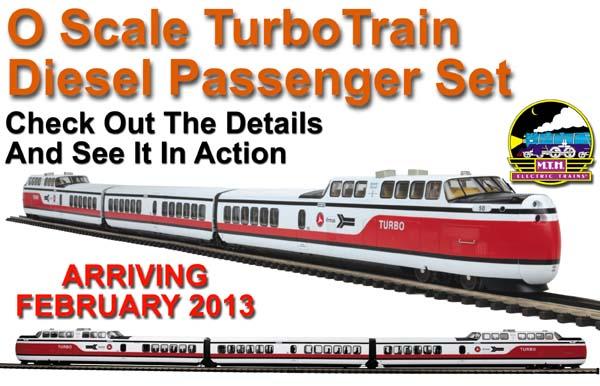
Check Out The Details And See It In Action: Premier Line O Scale TurboTrain December 18, 2012 - The M.T.H. Premier Line TurboTrain diesel passenger set is slated to ship to M.T.H. Authorized Retailers in early February 2013 after it exits our production facilities in late December. Check out the set's details in the photos below or click on the video icon to the left to see it in action in CN livery. The TurboTrain was largely the brainchild of one man, Alan R. Cripe. Fresh out of college in the 1950s, Cripe joined the Chesapeake & Ohio’s Train X project. He eventually led the development of plans for a high-speed, diesel powered train with cars that would tilt outward on curves, much like a pendulum, to allow higher speeds on existing track. The train was never built, however, and Cripe moved on, only to be approached years later by United Aircraft Corp. (UAC) to resuscitate his ideas. Armed with tilting train patents purchased from the C&O, United and Cripe won a government contract to build demonstration trains under the High Speed Ground Transportation Act of 1965. Introduced in 1967, the TurboTrain was, according to UAC, “a modern, streamlined, high-speed intercity passenger train designed by aerospace engineers and based on the principles of flight.” There was little exaggeration in those claims. The tilting cars allowed passengers to comfortably cruise through curves 30% to 40% faster than conventional trains. Power was provided by up to seven (depending on configuration) Pratt & Whitney aircraft-style gas turbine engines. The engines and many other components were designed to be changed out quickly for ease of maintenance. Seating was comparable to first-class airplane accommodations and, according to famed railroad writer William D. Middleton, “The over-the-engineer’s-shoulder, straight-ahead view from the forward dome represents the best railfan seating since the Electroliner.” Owned by the Department of Transportation, the TurboTrains went into U.S. service in 1968 between Boston and New York, operated first by Penn Central and later by Amtrak. Canadian versions, purchased by Canadian National Railways and assembled by Montreal Locomotive Works, served briefly in 1968-1969 and later entered Montreal–Toronto service in 1973. Why was the TurboTrain ultimately a failure, with no more units built, the U.S. trains retired in 1976, and the Canadian Turbos out of service by 1982? The conventional wisdom is that they were trouble-prone — but in fact the Canadian trains, after some initial teething problems, boasted a 97% availability record on CN and VIA Rail. Perhaps the greater truth is that the railroads involved could not get comfortable with a jet-powered land vehicle, and that the U.S. government and the railroads were simply not ready to make a commitment to providing competitive passenger service. Today’s Acela seems confirmation that Alan Cripe indeed had the right idea. With its low-slung aerodynamic design, tilting cars, and double-ended trainsets, the Acela is in many respects an electric-powered TurboTrain — but without the magnificent view from the domes. Forty years and billions of dollars later, the Acela’s best Boston–New-York time is only nine minutes faster than the Turbo’s schedule, and the Acela has yet to beat the 170.8 mph speed record set by the TurboTrain in 1967. M.T.H. Electric Trains is proud to introduce the first O scale model of the magnificent experiment that was the TurboTrain. Imagine what might have been, as you run this superbly detailed model in its original U.S. 3-car configuration — or add a car to simulate the trains as they were expanded to meet passenger demand.
